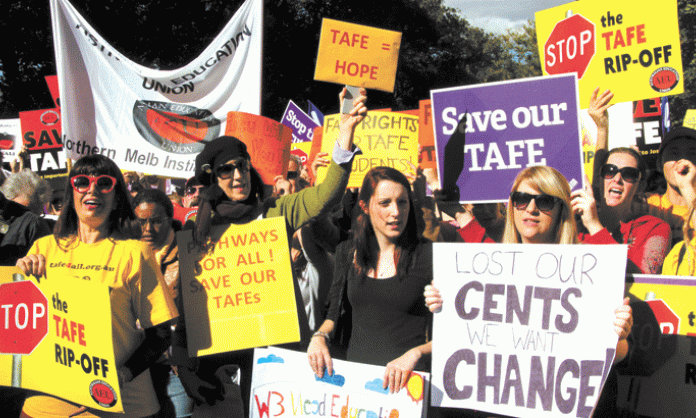During the federal election campaign, the Coalition unveiled its “Students First” schools policy, claiming to “deliver better education outcomes by providing more say for parents and teachers, a sound national curriculum, improved quality teaching, and certainty over school funding”.
But the only certainty over school funding is that governments across the country are taking to it with an axe. With the Coalition now in power federally, and in the four biggest states, teachers and students are facing a future of bigger class sizes and fewer resources.
School funding slashed
In Victoria the former Labor government, in power between 1999 and 2010, retained the cuts made in the 1990s by Liberal Premier Jeff Kennett, who destroyed 9,000 permanent teaching jobs and closed more than 300 schools. Short term contracts and wage freezes became the norm. A further $490 million was cut from the state education budget by Liberal Premier Ted Baillieu in 2011.
In New South Wales, a Boston Consulting Group report, commissioned in secret by the former Labor state government and leaked in early 2010, proposed closing 100 government schools, axing 7,500 teaching and 1,500 school support jobs, selling “surplus” school land and cutting programs for disadvantaged students. The leaking of the report created a public outcry, beating back Labor’s plans to cut education until its election loss.
But last year NSW Liberal Premier Barry O’Farrell announced his government would slash education spending by $1.7 billion over four years, claiming the cuts were “difficult but necessary”. Public schools will have their budget gouged by $200 million per year, and 1,800 jobs will be lost.
In Western Australia, education minister Peter Collier attempted to hide education cuts in the August budget, claiming spending on education had “actually increased” to $4.4 billion, up from $2.8 billion in 2007-08. But after initially denying jobs would be lost, Collier later revealed 350 education assistants’ jobs would go.
Cuts of 30 percent to the WA School Support Program Resource Allocation – which tackles behavioural issues and literacy and numeracy – are expected to produce hundreds of teacher job losses, hitting hardest the schools that need teachers most.
TAFE colleges face the axe
State cuts have hit TAFEs particularly hard. The Victorian Liberal government cut TAFE spending by $300 million last year.
Other states have followed suit. The NSW government announced last year that it will cut $80 million and 800 teaching jobs from TAFE, while increasing student fees by 9.5 percent. The Queensland government has cut $78.8 million from training, tertiary education and employment and plans to reduce the number of TAFE colleges from 13 to six or seven.
The WA government has imposed fee hikes for TAFE courses this year that the State School Teachers’ Union estimates to be worth $50 million over four years. In South Australia, the Labor government has announced cuts to TAFE of $9.6m in 2014-15, increasing to $21.9m each year thereafter.
Independent public schools
The Coalition’s “Students First” policy proposed an acceleration of the move to implement “independent public schools” (IPS), which it claims “will lead to higher productivity [and] better quality education”.
The new education minister, Christopher Pyne, held up Western Australia’s IPS model as an example to follow. Since 2009, 255 WA state schools have been re-badged as “independent”, with a target of nearly two-thirds of state schools to “line up and sign up” to become “independent” by the end of this year.
The WA government’s devolution of school funding is looking increasingly like Jeff Kennet’s attack on Victorian public education in the 1990s.
Between 1992 and 1999, his government devolved 93 percent of the public education budget to individual schools. Over the same period, 600 schools were amalgamated or closed, four and a half thousand teachers were designated in “excess of need”, and school cleaning was privatised.
The ‘education revolution’
The federal Liberals’ enthusiastic push for IPS follows in the footsteps of Labor’s “education revolution”, championed by former education minister and Prime Minister Julia Gillard. Gillard embraced the overhaul of New York schools by mayor and media tycoon Michael Bloomberg.
This overhaul, led by Joel Klein, the former chief executive of the international media company Bertelsmann, closed hundreds of New York schools and threatened others with closure if they didn’t become charter schools (i.e. publicly funded but privately run). Klein told Fortune magazine, “We’re converting the role of the principal into a CEO role.”
In August 2008, Gillard told the Australian Council for Education Research, “We can learn from Klein’s methodology of comparing like-schools with like-schools and then measuring the differences in school results in order to spread best practice.”
Gillard’s “education revolution” implemented NAPLAN, a regime of standardised testing for all school students every two years, and the My School website. In the US and Britain, standardised testing and “leagues tables” have led to the closure or privatisation of hundreds of schools.
Resisting corporatisation
Over two terms of federal government, between 2007 and 2013, Labor worked hand in glove with state governments – both Labor and Coalition – to push a pro-corporate agenda in education. This attack is now being accelerated in the wake of the Coalition’s federal election victory.
The effects are being felt. Private and “selective” state schools, the beneficiaries of increased state funding, provide the opportunity for kids from middle class and wealthy families to succeed, while those from working class backgrounds are being left behind.
A united campaign by the education unions is sorely needed to defend public education and reverse these attacks.
Last month, 20,000 teachers and parents mobilised for stop-work rallies across Western Australia. Tens of thousands more have mobilised against education cuts in other states over the last year. Yet union campaigns have stalled after one or two symbolic protests, giving way to petitions and lobbying of members of parliament.
If the erosion of our public education system is to be reversed a fightback is needed. Teachers and students will need to strike for “Education for all, not just the rich!”








